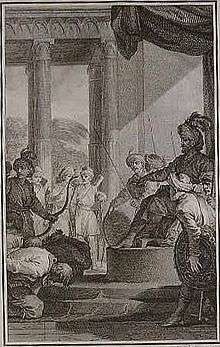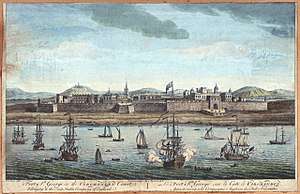Anglo-Mughal War
The Anglo-Mughal war,[2][3] popularly known as Child's war, was the first Anglo-Indian war and the earliest British attempt of colonization in the Indian Subcontinent that lasted from 1686 to 1690.
| Anglo-Mughal War | |||||||
|---|---|---|---|---|---|---|---|
| Part of Anglo-Indian Wars | |||||||
 French illustration of a soldier of the British Army requesting pardon from the Islamic Mughal Emperor Aurangzeb. | |||||||
| |||||||
| Belligerents | |||||||
|
| ||||||
| Commanders and leaders | |||||||
|
|
| ||||||
| Strength | |||||||
|
308 at Kolkata unknown at Mumbai and Carnatic | unknown but larger | ||||||
| Casualties and losses | |||||||
| Heavy at Mumbai and Kolkata | Several ships captured and destroyed and many civilians killed | ||||||

The British East India Company had been given a monopoly and numerous fortified bases on western and south-eastern coast of the Mughal India by the British Crown, permitted by the local governors.
In 1682 William Hedges (colonial administrator) was sent on the behalf of the Company to negotiate the Governor of the proto-industrialised Bengal Subah, Shaista Khan and to obtain a firman, an imperial directive that would allow the English Company regular trading privileges across the Mughal provinces.
In 1685, after some breaking of negotiations by Sir Josiah Child, Bt, the Governor of Bengal reacted by increasing the tributaries of the trade with the north-east from 2% to 3.5%. The company refused the newly introduced taxes and began to force the province of Bengal to accept new terms in the favour its trading power and expressed to capture Chittagong, establish a fortified enclave throughout the region, and attain independence of the surrounding subah from the Mughal territory by bringing the local governors and the Hooghly River to their control, which will later allow to form relationships with the Kingdom of Mrauk U based in Arakan (today's Myanmar) and hold substantial power in the Bay of Bengal.
Upon request, King James II of England sent warships to the company based in India, but the expedition failed.[4] Following the dispatch of 12 warships with the British troops, a number of battles took place and led to Siege of Mumbai and burning of the city of Balasore. New peaceful treaties were negotiated, but the East India Company failed to reach an agreement. The British naval forces caused the blockage of the Mughal ports on the western coast and attacked the Mughal Army, and vessels containing pilgrims to Mecca were also captured.
The conflicts heavily affected major cities like Mumbai, Madras, Kolkata and Chittagong, which resulted the intervention of Emperor Aurangzeb, who seized all the factories of the company and arrested members of the British Army, while the company forces commanded by Sir Josiah Child, Bt captured further Mughal trading ships and set the houses on fire of many faujdars.
Ultimately the British East India Company was defeated by the army of the Mughal Empire and the company was fined 150.000 rupees (roughly equivalent to today's $4.4 million). The company's apology was accepted and the old firman was granted by Emperor Aurangzeb.[5]
Background
In 1682 the English East India Company sent William Hedges to Shaista Khan, the Mughal governor of Bengal Subah, in order to obtain a firman: an imperial directive that would grant England regular trading privileges throughout the proto-industrialised Mughal Empire, the world's largest economy of that time. After the intervention of the company's governor in London, Sir Josiah Child, with Hedges's mission, causing Mughal Emperor Aurangzeb to break off the negotiations. After that Child started a war with the Mughals.[6]
Events of the War
In 1685 Admiral Nicholson was sent out with twelve ships of war, carrying 200 pieces of cannon and a body of 600 men, to be reinforced by 400 from Madras. His instructions were to seize and fortify Chittagong, for which purpose 200 additional guns were placed on board, to demand the cession of the encompassing territory, to conciliate the Zamindars and Taluqdars, to establish a mint, and to enter into a treaty with the ruler of Arakan. But the fleet was dispersed during the voyage, and several of the vessels, instead of steering for Chittagong, entered the Hooghly, and being joined by the Madras troops, anchored off the Company's factory.
The arrival of so formidable an expedition alarmed Shaista Khan, and he offered to compromise his differences with the English; but an unforeseen event brought the negotiation to an abrupt close. Three English soldiers, strolling through the marketplace of Hooghly, quarrelled with Mughal officials, and were severely beaten. After that the English admiral opened fire on the town and burnt down 500 houses.
In 1686, new negotiations started in Chuttanutty which the Mughals prolonged till their troops could be assembled to attack the English encampment, and English commander Job Charnock retired with his soldiers and establishments to the island of Ingelee, at the mouth of the Hooghly River. It was a low and deadly swamp, covered with long grass, without any fresh water. In three months one half of the English troops had died from disease.
In 1688, an English fleet was employed for blocking the Mughal harbours in the Arabian Sea on the western coast of India and ships with pilgrims to Mecca were captured. After that Emperor Aurangzeb Alamgir decided to resume negotiations with the English. However, the Company sent out reinforcements commanded by Captain Heath who on his arrival disallowed the treaty then pending and proceeded to Balasore which he bombarded and burnt. He then sailed to Chittagong; but finding the fortifications stronger than he had anticipated, landed at Madras.
After that Emperor Aurangzeb issued orders for the occupation of the British possessions all over the subcontinent, and the confiscation of their property. As a result, possessions of East India Company were reduced to the fortified towns of Madras and Bombay.[7]
In 1689, the strong Mughal fleet from Janjira commanded by the Sidi Yaqub and manned by Mappila from Ethiopian Empire besieged the British fort of Bombay.[8] After a year of resistance, a famine broke out which caused hundreds of deaths, the British surrendered, and in 1690 the company sent envoys to Aurangzeb's court to plea for a pardon and to renew the trade firman. The company's envoys had to prostrate themselves before the emperor, pay a large imperial fine of 1,50,000 rupees, and promise better behavior in the future. Emperor Aurangzeb then ordered Sidi Yaqub to lift the Siege of Bombay and the company subsequently re-established itself in Bombay and set up a new base in Calcutta.[6]
See also
References
- Blackburn, T.R. (2007). A Miscellany of Mutinies and Massacres in India. APH Publishing Corporation. p. 11. ISBN 9788131301692. Retrieved 2015-02-23.
- Hasan, Farhat (1991). "Conflict and Cooperation in Anglo-Mughal Trade Relations during the Reign of Aurangzeb"". Journal of the Economic and Social History of the Orient. 34 (4): 351–360. doi:10.1163/156852091X00058. JSTOR 3632456.
- Vaugn, James (September 2017). "John Company Armed: The English East India Company, the Anglo-Mughal War and Absolutist Imperialism, c. 1675–1690". Britain and the World. 11 (1).
- From Plassey to Partition, Śekhara Bandyopādhyāẏa, p39,ISBN 81-250-2596-0 Google book
- Keay, John. India: A History. New York: HarperCollins. 200. pg 372
- "Asia Facts, information, pictures | Encyclopedia.com articles about Asia | Europe, 1450 to 1789: Encyclopedia of the Early Modern World". encyclopedia.com. Retrieved 2015-02-23.
- The History of India from the Earliest Period to the Close of Lord Dalhousie's Administration by John Clark Marshman, 1867.
- Faruki, Z. (1935). Aurangzeb & his times. Idarah-i Adabiyāt-i Delli. Retrieved 2015-02-23.